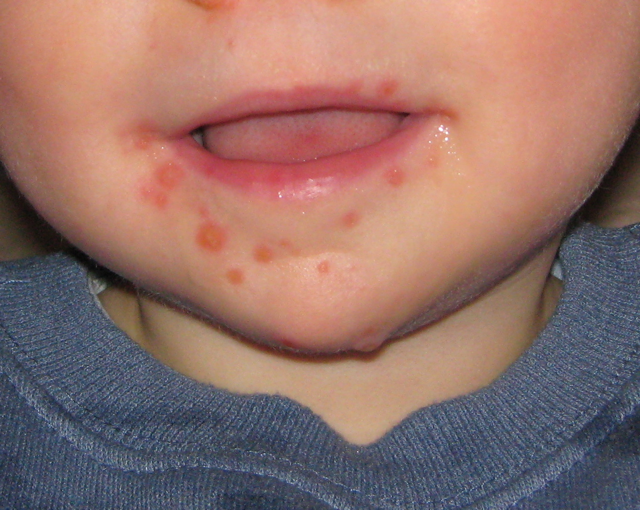WBR0153
| Author | PageAuthor::William J Gibson |
|---|---|
| Exam Type | ExamType::USMLE Step 1 |
| Main Category | MainCategory::Microbiology, MainCategory::Pathophysiology |
| Sub Category | SubCategory::Dermatology, SubCategory::General Principles |
| Prompt | [[Prompt::A mother brings her two year old boy into your office complaining of irritability, poor appetite and diarrhea for the past two days. He has developed a rash surrounding his mouth (pictured below) and a similar rash on his hands and feet. Which of the following describes the most likely causal organism?
 |
| Answer A | AnswerA::Enveloped ssRNA virus with icosahedral capsid symmetry |
| Answer A Explanation | AnswerAExp::'''Incorrect''' - This describes Rubella virus which causes a fine truncal rash and postauricular lymphadenopathy |
| Answer B | AnswerB::Enveloped dsDNA virus with icosahedral capsid symmetry |
| Answer B Explanation | AnswerBExp::'''Incorrect''' - This describes viruses of the herpesviridae family including HSV1 and VZV. HSV1 can cause an vesicular rash near the mouth like the one pictured, but does not cause rash on the hands or feet. |
| Answer C | AnswerC::Nonenveloped dsDNA virus with icosahedral capsid symmetry |
| Answer C Explanation | AnswerCExp::'''Incorrect''' - This describes adenovirus which is responsible for pink eye, not hand foot and mouth disease. |
| Answer D | AnswerD::Nonenveloped ssRNA virus with Icosahedral capsid symmetry |
| Answer D Explanation | AnswerDExp::'''Correct''' - See explanation |
| Answer E | AnswerE::Spirochete |
| Answer E Explanation | AnswerEExp::'''Incorrect''' - While Syphillus can cause a rash on the hand and feet it does not cause this sort of rash on the mouth and it is much more likely that the child has hand foot and mouth disease. |
| Right Answer | RightAnswer::D |
| Explanation | [[Explanation::Explanation: The child in this vignette is affected by hand foot and mouth disease as a result of infection by Coxsackievirus A, an intestinal virus of the picornaviridae family. Hand foot and mouth disease is a contagious disease that usually affects infants and children. Affected individuals experience fever, headache, fatigue, malaise sore throat, and a characteristic body rash followed by sores with blisters on palms of the hands, soles of the feet and around the mouth. Picornaviridae such as coxsackie are nonenveloped ssRNA viruses with icosahedral capsid symmetry.
As an aside, the Coxsackie B virus causes myocarditis. Educational Objective: Coxsackie A virus causes hand foot and mouth disease. Coxsackie A is a picornavirus which is a nonenveloped, ssRNA virus with icosahedral capsid symmetry. References: First Aid 2012 page 200 |
| Approved | Approved::Yes |
| Keyword | |
| Linked Question | Linked:: |
| Order in Linked Questions | LinkedOrder:: |